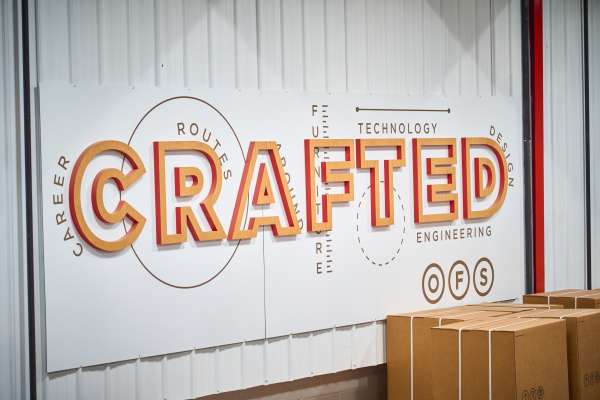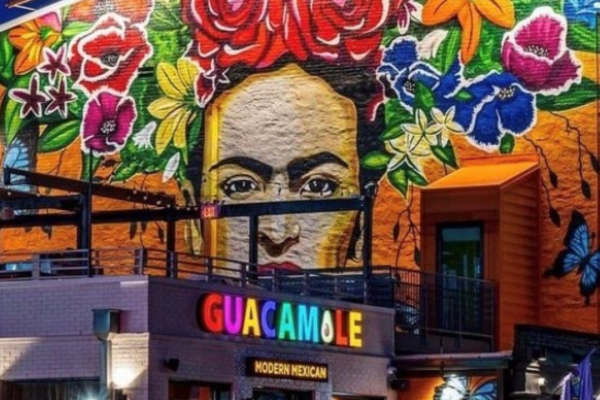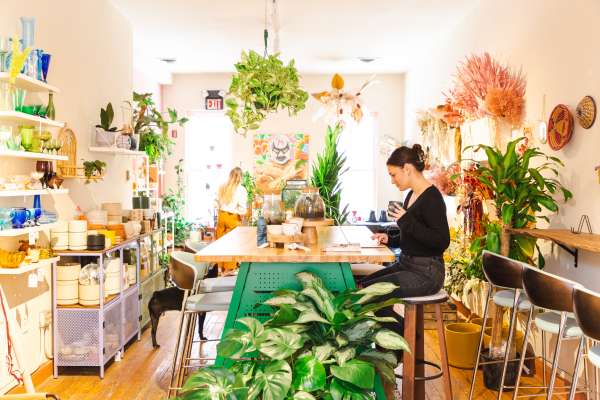Reuniting art with architecture
A visit to the J. Irwin Miller Architecture Program in Columbus, Indiana.
In the heart of the midwest, the small city of Columbus, Indiana, claims a uniquely rich architectural pedigree, with a vast collection of mid-century modernist masterpieces. Today, the Columbus tradition of architectural excellence is carried on by students and faculty in the J. Irwin Miller Architecture Program. This unique school is part of Indiana University’s Eskenazi School of Art, Architecture + Design, whose main campus is located 36 miles west in Bloomington, Indiana. The inventive work of these students in the context of their historic surroundings is bringing new creative life to one of the most modern architectural communities.
"Athens of the prairie"
Columbus, Indiana, has long earned its unlikely title: “Athens of the prairie.” In the rural countryside south of Indianapolis, the city is home to less than 50,000 residents, but boasts over 60 architectural masterworks from Eero Saarinen, Harry Weese, Kevin Roche, I.M. Pei, and other giants of the mid-century modernist movement.
To understand how this unexpected place came to be, we need to dig deeper into the story of a singular community and the leaders who helped cultivate design excellence there. While many figures have contributed to the architectural history of Columbus, one family has played a significant role: the Millers.
Born and raised in Columbus, J. Irwin Miller grew up around his family business, the automotive and heavy equipment manufacturer Cummins. In 1934, Irwin joined the company, and after serving in the Pacific Theater during World War II, Irwin took on the role of President in 1947. In addition to playing a key role in the American civil rights movement, Irwin invested heavily in his own community of Columbus.
In the mid-1950s, Irwin established the Cummins Foundation, which would subsidize the design and construction of public buildings in Columbus. Irwin was known for saying, “Nothing is more expensive than mediocrity,” a statement he backed up by hiring some of the finest architects and designers of the era to complete these projects, from Robert Venturi to Alexander Girard.
Irwin’s dream was for the city’s public spaces to provide more than just functional settings for commerce or education. He wanted to inspire people with beautiful places that changed how they thought and helped them thrive. Irwin’s work was carried on by his son, Will, who has played a role in preserving and promoting the city’s architectural tradition.
“Will has been a huge advocate for architecture and design and what it means to this community. He recognized the need to take advantage of our architectural heritage here since his family helped develop and build it,” said Hutch Schumaker, President of the Coca-Cola Bottling Co., in Columbus.
The Millers’ spirit of community investment and design appreciation has deeply shaped the culture of Columbus. There is a strong current of collaboration between businesses,non-profit organizations, and local government that drives economic and cultural development across the city—known to locals as “the Columbus way.”
“Mr. Miller always used to say, ‘The process is more important than the product,’ because we don’t know what we’re going to be working on together in the future, but nothing is more important than the way we treat one another in the process of working toward solutions. When you come to a place like Columbus, the question becomes, does the built environment really make a difference? Was Winston Churchill right when he said, ‘We shape our buildings, and afterwards our buildings shape us’?” said Jack Hess, Executive Director of CivicLab.
If any city can present a compelling case that buildings do shape us, it may be Columbus. That’s precisely why it was chosen as the ideal location for Indiana University’s new graduate program of art, architecture, and design.
 The journey to creating Indiana University’s new Art, Architecture + Design program began about nine years ago, when the President of Indiana University, Michael McRobbie, met with faculty and Columbus community members to discuss the benefit of design partnerships.
The journey to creating Indiana University’s new Art, Architecture + Design program began about nine years ago, when the President of Indiana University, Michael McRobbie, met with faculty and Columbus community members to discuss the benefit of design partnerships.
“President McRobbie and Provost Lauren Robel had an interest in design as a whole, and the faculty saw it as an opportunity to join together the disciplines of both art and design. So today we have three accredited bodies, which is pretty impressive for a school of our size,” said Peg Faimon, Founding Dean of the Eskenazi School of Art, Architecture + Design.
Recognizing the tremendous opportunity this posed for the city, Columbus offered to donate one million dollars to the school.
“The architecture in Columbus is an asset, so the question becomes, are you using your assets to their highest and best value? For us, this school was an opportunity to use our architecture in an educational way and enhance the value of what we’ve already got,” said Mayor Jim Lienhoop of Columbus.
With the main campus of Indiana University in Bloomington, only 40 minutes away, Columbus was the perfect living laboratory for students of architecture.
“This community is focused on public-private partnerships all attuned to the question of design and how we can make space better through the lens of architecture, so Columbus itself was a big part of the draw here,” said first-year student Meg Fitzpatrick.
 Kelly Wilson, Director of Graduate Studies for the new program, shares a memory from his first trip to Columbus and explains walking across the plaza where the Henry Moore sculpture meets the First Christian Church by Eliel Saarinen and I.M. Pei’s library.
Kelly Wilson, Director of Graduate Studies for the new program, shares a memory from his first trip to Columbus and explains walking across the plaza where the Henry Moore sculpture meets the First Christian Church by Eliel Saarinen and I.M. Pei’s library.
“It was twilight, and as I walked across that plaza, my heart skipped a beat. I felt hope. It’s an incredibly powerful thing, to make you think that the best possible thing that could be invented with human endeavor and human energy was embedded into the DNA of this city. This is some strong medicine for an architecture program. Students here feel that they can invent boldly with their communities and know that their community will respect what they are doing. This is a wonderful thing,” Wilson said.
Reuniting art with architecture
While the backdrop of Columbus for Indiana University’s J. Irwin Miller Architecture Program (Miller M.Arch program) makes for an enriching and unique environment, the curriculum and structure of the school is similarly novel.
For Kelly Wilson, it was a chance to encourage the unique voices of students. After years of teaching at many Ivy League schools along the East Coast, he hoped to empower and equip students to put forth their own vision. “What I began to notice was that there was less room for individuality and the ability to think for yourself and invent meaningfully from something you personally believe,” Wilson said.
With a firm belief in the relationship between art and architecture, Wilson helped develop a curriculum that has expanded today’s traditional architectural mandate and placed an emphasis on reuniting the two disciplines.
“The opportunity I had here for setting this program up was the idea that if you could wed artistic inquiry and architectural inquiry to each other again, and give a student the opportunity to think visually and learn to make an accord with the things they draw, paint, and observe as part of their artistic practice, they may be able to find belief in how they think visually, and the meaning with which visual ideas are produced and created and felt to inform the way in which they think about architecture, and vice versa, to let those two things to mix with each other,” Wilson said.
The program involves an annual nomadic studio course that takes students abroad to analyze some of the world’s greatest architecture. Through rigorous drawing studios and visual studies coursework, students begin to realize that the people behind such prominent buildings and public spaces were not actually architects.
“They all came up through guilds in sculpture or painting or ceramics. Some of the most remarkable inventions occurred in the Renaissance to architecture as a consequence of artists being asked to produce buildings. The question became so obvious to me: How come we don’t learn both of these things at the same time?” Wilson asked.
While many architecture programs are becoming more digital, the Miller M.Arch program believes that drawing is a key tool for an architect’s visual, creative process in learning to see living order.
“So we go to all of these buildings around town and draw their plans, their elevations, and create drawings from different perspectives. Then we ask, ‘What can you say about this building because of what you drew?’ and what you find is that drawing slows down the process of looking, and makes you ingest and digest what you’re looking at. You see things you would have never seen before. I’m fond of telling them, ‘You pick up a camera, you’ll poke your eye out,’” Wilson said.
Very few schools have attempted to try something different with architectural education, but Miller M.Arch’s uncommon curriculum is attracting a diverse range of students from all backgrounds, creating an even more inimitable environment.
A cohort of risk-takers
With such a new program, the school has attracted applicants from a broad range of backgrounds.
“The people we are getting are risk-takers, and there’s something very special about that. It’s something that as we continue to grow, we want to continue to tap into and recruit students and faculty who are interested in the new and don’t mind ambiguity,” Faimon said.
 Like anything new, the program is a genuine experiment, but the willingness of both educators and students to take that risk has inspired and helped to build a community that cultivates innovation and change.
Like anything new, the program is a genuine experiment, but the willingness of both educators and students to take that risk has inspired and helped to build a community that cultivates innovation and change.
“I find the students to be incredibly driven and vocal. They are not afraid to let you have it, good or bad, and I really like that. They challenge you as much as you challenge them, and I think that friction makes for a good environment for creative education,” said Daniel Martinez, Assistant Professor.
Wilson agrees that the different backgrounds of students encourage animated and energized conversations in the classroom.
“We have students coming in with masters or from Ph.D. programs, we have all different age groups and different ethnicities, and the collective they produce is eclectic and wonderful, because they don’t share the same mindset, and you want sparks in your program. You don’t want fire, but you want sparks,” Wilson said.
Respectful competition with one's ancestors
Building the program has been a long journey, but for these students, faculty, and community members, this is just the beginning.
“Artists are one of the few kinds of people I know who are willing to go to the edge of the unknown, because they have something called the anticipatory power of the art. They can feel the presence of things that have yet to be born into the world. And they holler them in. Most folks don’t want to have that feeling of uncertainty, to stand at the edge of an unknown,” Wilson said.
J. Irwin Miller was known for saying, “A good life is one led in praiseworthy competition with one’s ancestors.” The program that now bears his name seems a fulfillment of that belief. Not only are the students of the program doing inventive, creative work in the tradition of past architects, they are doing so while surrounded by some of architecture’s greatest voices and works.
“Artistic inquiry is one of the frontiers of discovering what human nature is truly capable of. That’s what I want our students of architecture to feel and sense—this magnetic pulse that comes from things that you can barely describe, but you feel, as you try to cultivate them into form and meaning. That’s what we’re trying to build,” Wilson said.























